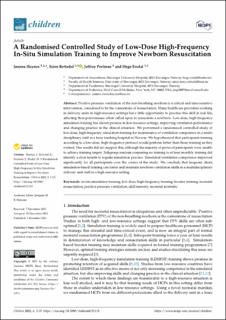| dc.contributor.author | Haynes, Joanna Clare | |
| dc.contributor.author | Rettedal, Siren | |
| dc.contributor.author | Perlman, Jeffrey M. | |
| dc.contributor.author | Ersdal, Hege Langli | |
| dc.date.accessioned | 2022-01-26T10:12:39Z | |
| dc.date.available | 2022-01-26T10:12:39Z | |
| dc.date.created | 2022-01-18T10:49:48Z | |
| dc.date.issued | 2021-12 | |
| dc.identifier.citation | Hayes, J.C., Rettedal, S., Perlman, J.M., Ersdal, H.L. (2021) A randomised controlled study of low-dose high-frequency in-situ simulation training to improve newborn resuscitation. Children, 8 (12), 1115. | en_US |
| dc.identifier.issn | 2227-9067 | |
| dc.identifier.uri | https://hdl.handle.net/11250/2839401 | |
| dc.description.abstract | Positive pressure ventilation of the non-breathing newborn is a critical and time-sensitive intervention, considered to be the cornerstone of resuscitation. Many healthcare providers working in delivery units in high-resource settings have little opportunity to practise this skill in real life, affecting their performance when called upon to resuscitate a newborn. Low-dose, high-frequency simulation training has shown promise in low-resource settings, improving ventilation performance and changing practice in the clinical situation. We performed a randomised controlled study of low-dose, high-frequency simulation training for maintenance of ventilation competence in a multidisciplinary staff in a busy teaching hospital in Norway. We hypothesised that participants training according to a low-dose, high-frequency protocol would perform better than those training as they wished. Our results did not support this, although the majority of protocol participants were unable to achieve training targets. Subgroup analysis comparing no training to at least monthly training did identify a clear benefit to regular simulation practice. Simulated ventilation competence improved significantly for all participants over the course of the study. We conclude that frequent, short, simulation-based training can foster and maintain newborn ventilation skills in a multidisciplinary delivery unit staff in a high-resource setting. | en_US |
| dc.language.iso | eng | en_US |
| dc.publisher | MDPI | en_US |
| dc.rights | Navngivelse 4.0 Internasjonal | * |
| dc.rights.uri | http://creativecommons.org/licenses/by/4.0/deed.no | * |
| dc.subject | pediatri | en_US |
| dc.subject | opplæring | en_US |
| dc.subject | gjenoppliving | en_US |
| dc.title | A randomised controlled study of low-dose high-frequency in-situ simulation training to improve newborn resuscitation | en_US |
| dc.type | Peer reviewed | en_US |
| dc.type | Journal article | en_US |
| dc.description.version | publishedVersion | en_US |
| dc.rights.holder | © 2021 by the authors | en_US |
| dc.subject.nsi | VDP::Medisinske Fag: 700::Klinisk medisinske fag: 750::Pediatri: 760 | en_US |
| dc.source.pagenumber | 1-12 | en_US |
| dc.source.volume | 8 | en_US |
| dc.source.journal | Children | en_US |
| dc.source.issue | 12 | en_US |
| dc.identifier.doi | 10.3390/children8121115 | |
| dc.identifier.cristin | 1983323 | |
| dc.source.articlenumber | 1115 | en_US |
| cristin.ispublished | true | |
| cristin.fulltext | original | |
| cristin.qualitycode | 1 | |

